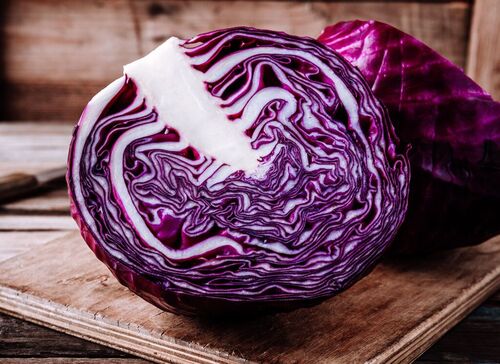Growing Red Cabbage

Red cabbage ( botanical name Brassica oleracea or B. oleracea var. capitata F. rubra ) is a variant of white hard-heading cabbage and a descendent of three distinct cabbage types within the Brassica family. The word "cabbage" is an Anglicized form of the French caboche, meaning "head." It has been used to refer to loose-heading and nonheading forms of Brassica oleracea. Red cabbage's colorings are due the presence of anthocyanins. These plant pigments produce red, pink, violet and magenta colors within different parts of food plants plants.
Sowing red cabbage
You can start seeds indoors (optional), so you'll need a tray, some red cabbage seeds, and starting soil. Place the tray in a sunny location such as a windowsill and make sure that the soil is always damp. Red cabbages are normally sown February to mid April for transplanting from April to early June and cropping between August and November.
Direct to the Red Cabbage Seeds >
Red cabbage plants and birds
Keep in mind that to birds, some plants are way tastier than others. Peas, lettuce, squash seedlings and cabbage family members seem to be the birds favorites. The only practical solution is using netting, which must be very fine and held well clear of the plants.
Planting out red cabbage
Plant your red cabbage seedling into rich soil and scatter some organic material into the soil. Aged manure or compost will work well. Make sure that the soil is well draining as cabbage cannot tolerate wet soil. Plant 24 inches (60 cm) apart in rows.
Fertilizing red cabbage
Prior to planting cabbage, make sure the soil is rich in nutrients. If possible, do a soil test to determine the specific nutrient needs of your soil. If you aren't able to do a soil test, mix 8-16-16 fertilizer into the soil two weeks before transplanting seedlings. Fertilize again about two to three weeks after transplanting, when the roots are established. Side dress with a high-nitrogen fertilizer such as a 46-0-0 or 27-3-3. If you planted in sandy soil or have a lot of rain that washes away nutrients, you may need to fertilize as often as every three weeks.
Harvesting red cabbage
Solid heads indicate when it is time for harvesting cabbage. When heads are firm all the way through when squeezed, the cabbage is ready for harvest. Heads may be large or small when ready, the size to pick cabbage varies depending on the variety and the weather conditions the cabbage grew in. Simply pull from the ground gently or use a sharp knife to cut at the bottom.
Pests and Diseases
- Cabbage root fly - Stunted growth especially if infected as seedlings. Discoloured leaves which wilt. Roots are black and rotten.
- Club root - The first signs of infection are wilting. blueish leaves and a dying plant.
- Cabbage Caterpillars - Holes in the leaves
- Wirestem - Rotting stems on seedlings
- Cabbage Whitefly - White larva on undersides of the leaves and distorted leaves
Health benefits red cabbage
The health benefits of red cabbage may include prevention of premature aging and cancer, skin and eye care, aiding weight loss, and boosting the immune system, among other positive benefits.
Red Cabbage Nutrition Facts
One of the main reasons why red cabbage is such a popular vegetable is the wealth of phytochemicals, antioxidants, nutrients, vitamins, and minerals. These essential components include B-vitamins calcium, manganese, magnesium, iron, and potassium, as well as vitamin C, vitamin A, vitamin E, vitamin K, dietary fiber. Its organic compounds are almost too many to list, but its antioxidants like anthocyanins and indoles are extremely valuable for human health.
Varieties of red cabbage
- Red Cabbage Langedijker (winter)
- Red cabbage Red head
- Ruby Perfection F1
- Lodero F1



